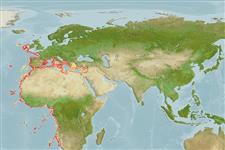Environment: milieu / climate zone / intervalo de profundidade / distribution range
Ecologia
marinhas batidemersal; não migratória; intervalo de profundidade 395 - 1700 m (Ref. 3587). Deep-water; 55°N - 27°S, 26°W - 36°E
Eastern Atlantic: Irish slope to Cape Verde, including the Mediterranean. Occurrence in southern Africa is based only on specimens from off Namibia and not 'west coast of South Africa' as reported by Iwamoto 1986 (Ref. 2800 in FishBase) (Ref. 11953).
Tamanho / Peso / Idade
Maturidade: Lm ? range ? - ? cm
Max length : 60.0 cm TL macho/indeterminado; (Ref. 11953); Idade máx. registada: 11 anos (Ref. 58045)
Snout long, narrow, sharply pointed. Dorsal scute row striating from just behind the head and extending to about behind a vertical through the anus, with more than 20 scute. Ventral scute row not reaching anus. Scute keels generally smooth blade-like, without multicuspid tips in small individuals (<30 cm), becoming more multicuspid with size. Scales adherent; belly completely scaled.
Body shape (shape guide): elongated.
Primarily a pelagic feeder, feeds primarily on pelagic copepods, but also takes mysids, shrimps, cephalopods, fish, polychaetes and gastropods (Ref. 1371). Mainly reduced to fishmeal and oil (Ref. 1371).
Life cycle and mating behavior
Maturidade | Reprodução | Desova | Ovos | Fecundidade | Larvas
Cohen, D.M., T. Inada, T. Iwamoto and N. Scialabba, 1990. FAO species catalogue. Vol. 10. Gadiform fishes of the world (Order Gadiformes). An annotated and illustrated catalogue of cods, hakes, grenadiers and other gadiform fishes known to date. FAO Fish. Synop. 125(10). Rome: FAO. 442 p. (Ref. 1371)
Categoria na Lista Vermelha da IUCN (Ref. 130435: Version 2025-1)
Ameaça para o homem
Harmless
Utilização humana
Pescarias: pouco comercial
Ferramentas
Relatórios especiais
Descarregue XML
Fontes da internet
Estimates based on models
Preferred temperature (Ref.
123201): 4.7 - 13.7, mean 10.4 °C (based on 141 cells).
Phylogenetic diversity index (Ref.
82804): PD
50 = 0.5176 [Uniqueness, from 0.5 = low to 2.0 = high].
Bayesian length-weight: a=0.00309 (0.00119 - 0.00804), b=3.12 (2.90 - 3.34), in cm total length, based on LWR estimates for this (Sub)family-body shape (Ref.
93245).
Nível Trófico (Ref.
69278): 3.6 ±0.3 se; based on diet studies.
Generation time: 3.7 ( na - na) years. Estimated as median ln(3)/K based on 2
growth studies.
Resiliência (Ref.
120179): Médio, tempo mínimo de duplicação da população 1,4 - 4,4 anos (K=0.22-0.35).
Fishing Vulnerability (Ref.
59153): Moderate vulnerability (38 of 100).
🛈
Climate Vulnerability (Ref.
125649): Low vulnerability (13 of 100).
🛈
Nutrients (Ref.
124155): Calcium = 23.5 [12.6, 51.5] mg/100g; Iron = 0.403 [0.201, 0.813] mg/100g; Protein = 16.7 [15.0, 18.4] %; Omega3 = 0.241 [0.109, 0.505] g/100g; Selenium = 26.3 [10.7, 61.6] μg/100g; VitaminA = 8.08 [1.67, 36.00] μg/100g; Zinc = 0.38 [0.25, 0.59] mg/100g (wet weight);
